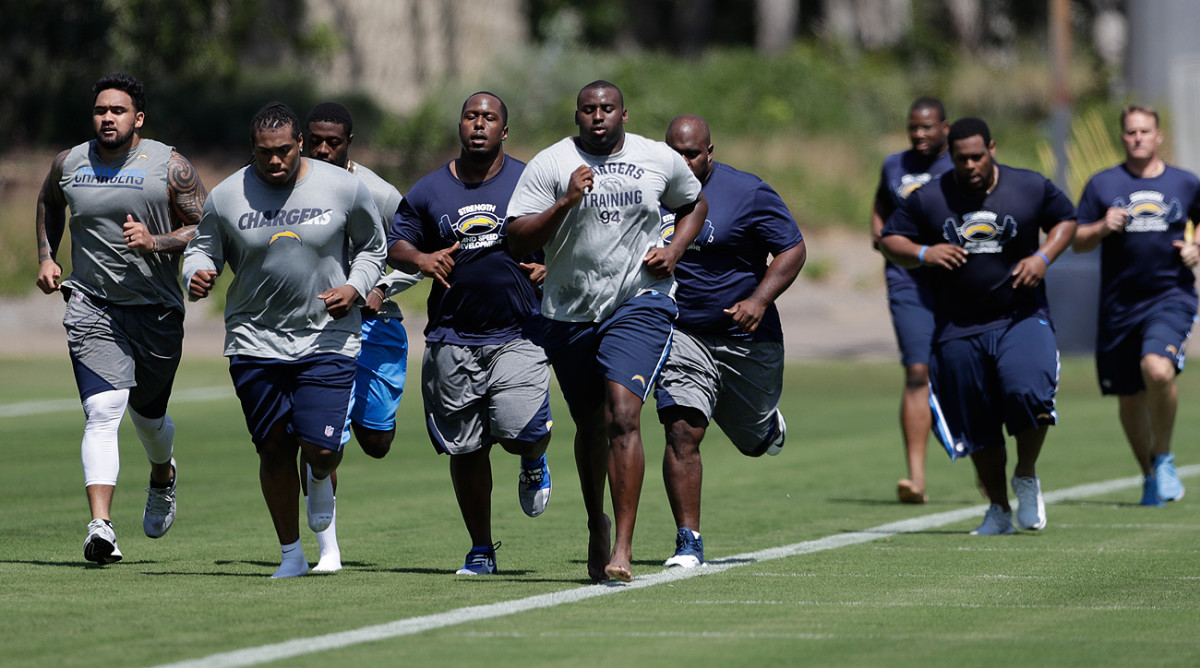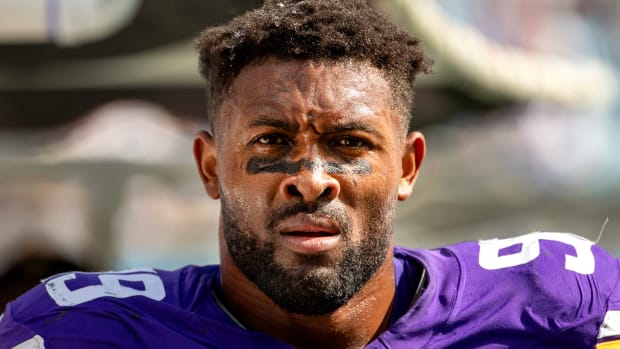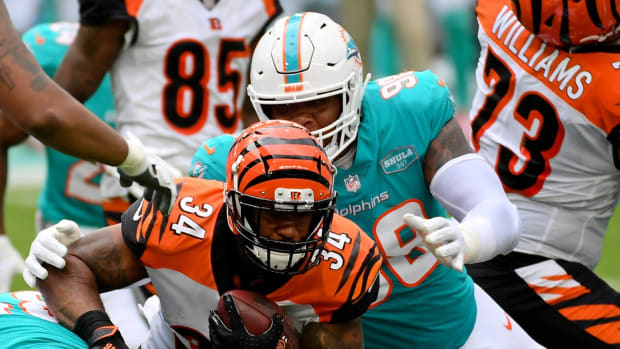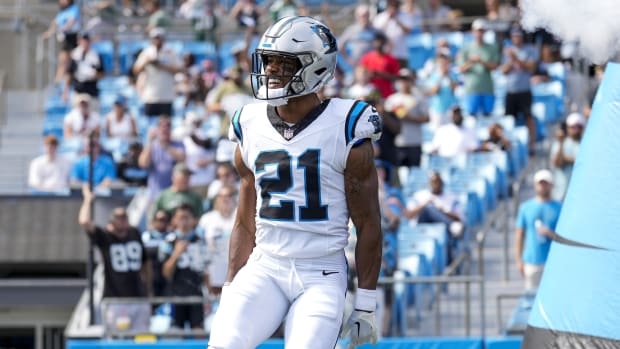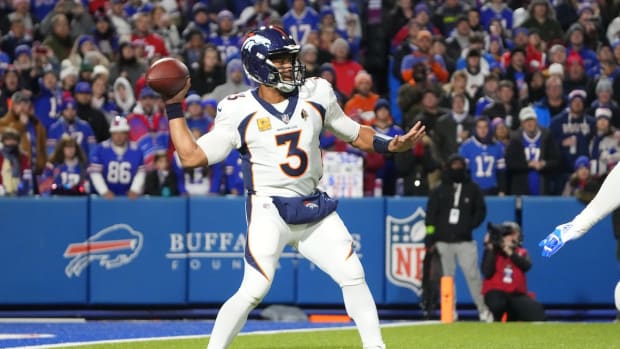Gassers and Excuses: How the Bolts Are Handling Move
Chargers coach Anthony Lynn was detailing how he tossed his players into an NFL time machine by putting them through what, by today’s standards, would qualify as a spring boot camp. And then, the thought popped in my head: So I guess the idea is when a guy is going through 200- and 300- and 400-yard gassers, it’s hard for him to be thinking about where his family’s going to be in June, huh?
Lynn laughed and said, “That’s a good way to put it.”
The Chargers are about halfway through as strange an offseason as any team, in any sport, in recent memory, has endured. They’re now the Los Angeles Chargers, but until the league breaks for summer in late June, the football work is still being done in San Diego. They have a new head coach. They just welcomed in a new rookie class. And all the while, groundwork for the move is being laid 100 miles up the coast.
In fact, on Wednesday, we talked as Lynn was in the middle of a quick trip to Orange County to move some things into his new house and do a site visit on work at the Chargers’ Costa Mesa facility, ahead of their July move-in date. The team had OTAs last week, and they’ll have OTAs next week, and this was the window for Lynn to knock out a couple off-field items.
This isn’t just reality for Lynn in 2017. It’s the reality of 2017 for all the Chargers.
“It really wasn’t ever an elephant in the room,” Lynn said. “I’m a pretty straight-forward guy. I let these guys know exactly where I stood, what the standard was and what the expectations were, and how we were going to go about doing it. … There’s a lot of character on this football team. And that’s why I believe this whole process that we could use as an excuse, we won’t use it as an excuse.
“I believe that, in a way, it’ll galvanize the whole organization and make us even closer and more focused on the task at hand.”

A common sight during new coach Anthony Lynn’s practices: Chargers players running gassers.
Gregory Bull/AP
In this week’s Game Plan, we’re going to look at where the union is on marijuana with four years left on the CBA; why the Raiders believe Derek Carr’s in for a big year (which would make it smart to pay him before that); how I can back up the assertion that Giants owner John Mara made to The MMQB’s Jenny Vrentas on Colin Kaepernick; and where new Bills GM Brandon Beane has already done impressive work.
We’ll start in southern California, and look at how Lynn is distracting his players from the shiny object hovering over them (the move) while working to improve the toughness and health of a team that’s lost too many close games (4-9 in one-score games in ’16) and has been too injured (26 players finished ’16 on IR).
And the way Lynn’s approaching that is about as subtle as an uppercut. As the new Chargers boss explains it, the training methods are the type he “was very familiar with growing up.” The owners gave him resources for the overhaul. The weight room has been rebuilt to emphasize power. The conditioning program was flipped on its head to incorporate more arduous, longer-distance running.
Research tells Lynn—as a side benefit to the sort of work that looks awfully Parcellsian from an ex-Tuna assistant—it all lines right up with getting more guys on the field and less in the training room when it counts.
“I don’t know if it’s old school training; I just think it’s basic training,” he said. “Phase I and Phase II (of the program), to me, was just conditioning, a different type of conditioning. We wanted to build a base for our players. In the fourth quarter, we want to be stronger, we want stamina, we don’t want to be fatigued. And I know a lot of soft-tissue injuries come from fatigue, not explosive movements.
“And our organization has stepped in big-time to help out with different training tools. We’ve revamped the strength-and-conditioning area. That thing, you walk in there, it’s built for power. It doesn’t look like a 24-Hour Fitness. And guys have bought into that direction.”
There’s more coming, too.
Lynn acknowledges there’s no way to eliminate injuries, but he’ll work to try to nip in the bud any hint of a culture where, as he put it, “it’s easier to be hurt sometimes.” As such, at camp, you may see training-camp scenes involving injured guys like you used to a decade ago.
“Guys won’t be standing around doing nothing, I can promise you that,” Lynn said. “There will bikes on the field at training camp. Yes, there will.”
The overarching theme here takes us back to the top of the story—Lynn wants to take away any excuse that might be sitting there for his first Chargers team, acknowledging there’s a pretty easy one to make.
But it goes beyond just the obvious. In fact, when I brought up the talented young core around Philip Rivers, who Lynn calls “exactly what you’re looking for in a quarterback,” and mentioned the injuries of the past two years as a reason why the team didn’t hit its potential, the coach wasn’t having it.
He could’ve talked about defensive studs Joey Bosa and Melvin Ingram and Denzel Perryman, or offensive breakthrough players Hunter Henry and Melvin Ingram, and explained where all the group could be if it just has a healthier season. But he didn’t.
“To me, that’s just excuses,” Lynn said. “It’s the National Football League, and we’re all talented. I mean, this is an elite group of men. I don’t think there’s a non-talented team in the National Football League. The facts are, and I deal in the currency of the truth, we won nine games the past two years. We’re below average. So we have to change some things that we’re doing. We have to approach it better. We have to play better.
“And we have elite talent—just like everyone else. What we do with it is what’s most important.”
It’s important to mention that all of this isn’t exactly how Lynn expected it to go. Was the move possible when he took the job in mid-January? Sure. Was it likely? Not as he saw it.
So he’s had to adjust on the fly, which is fine with him. And he knows that over the next few months, his team will have to be just as adaptable. Or else they’ll risk sinking in circumstances.
“When I took the job, we were still in San Diego. And four days later, we made the decision to move,” Lynn said. “I have to be honest with you, I didn’t think we were going to be leaving San Diego. I really didn’t. It wouldn’t have mattered much. I was looking at the organization and I felt like the organization was a fit for me. But I did have to start thinking about things differently, once we decided we were moving.”
The best way to do that, evidently, has been to bury himself and his team in the kind of football work that’s now considered vintage. Unique approach for a unique situation. What comes out of it—based on this most unusual setup for an NFL team’s calendar year—is still anyone’s guess.
* * *
FIRST AND 10

The Jets are anticipating big things from rookie defensive backs Jamal Adams (33) and Marcus Maye.
Julio Cortez/AP
1. In case you wondered, Lynn told me he has gotten a few drive-by expletives from angry fans outside Charger Park. But he reports, as a whole, the city has been “just outstanding” to him under these very weird circumstances.
2. The Jets’ focus this year is on finding young building blocks, and early signs are good that they’ve got the interchangeable safeties that Todd Bowles wants with rookies Jamal Adams and Marcus Maye flashing their instincts and speed.
3. Good to see Chiefs rookie Patrick Mahomes gaining confidence. We’ll reiterate what we reported a couple weeks ago: He will compete to start when he breaks the huddle thinking about the defense, rather than the offense.
4. When the NFL farmed out Thursday Night Football to the networks, they wanted to make sure it was treated as a big deal. So they insisted on having “A” teams. Which is why it always made sense to bend that rule to allow NBC to use Mike Tirico, an A-teamer without question.
5. There’s no doubt the Lions feel like Ricky Wagner and TJ Lang are upgrades over Riley Reiff and Larry Warford up front. But a bigger reason for their O-line optimism? They believe they have a franchise left tackle in Taylor Decker.
6. Sometimes players will take their foot off the accelerator coming off a breakout year. So Landon Collins’ motivation to build on his 2016 as OTAs start has been well received by the Giants.
7. Clearly, the Titans thought a lot of Corey Davis to pick him higher (fifth overall) than anyone expected. But there’s another rookie wideout there to keep an eye on: third-rounder Taywan Taylor has turned heads at OTAs.
8. No one should be surprised if running back Dalvin Cook has a gigantic rookie year for the Vikings. He fell because of his off-field flags. And while his testing numbers raised some concern, the scouts I talk to universally love his college tape.
9. No one needs to be concerned about the comments Redskins cornerback Josh Norman made to Bleacher Report’s Ty Dunne. Some players can’t handle the firestorm they create for themselves in these situations. Norman’s generally been the opposite of that.
10. Name to keep an eye on for the 2018 or ’19 draft: Nevada QB David Cornwell. The graduate transfer wasn’t the best program fit for Alabama, and never started a game there. But he has tools and could thrive in his new home.
* * *
FOUR DOWNS

Not all fans were turned off by Colin Kaepernick’s decision not to stand for the national anthem.
Harry How/Getty Images
1. The Kaepernick story continues. I was able to stay away from topic in last week’s Game Plan. And I’m trying (I really am!!) to not hit you guys over the head with this story every week. But in the wake of what Giants owner John Mara said to my colleague Jenny Vrentas, I had a coach reach out with a story that I thought backed up what Mara said, and gave interesting context to where teams stand on this hot-button issue.
To set the stage: This particular coach is a quarterbacks coach, and his story is from last summer, right around the annual deadlines for teams to cut down from 90 to 75 and then 75 to 53 players. At that point, it wasn’t quite considered a sure thing that Colin Kaepernick was going to make the Niners roster, so there was a chance he’d become available, and his anthem protest had become public. “I got multiple messages on my office phone saying that if we signed Kap, people would stop watching and going to games,” the coach said. “And I’m just the quarterbacks coach. The one I really remember was some older guy who said, ‘My friends and I have talked and if you guys sign Kaepernick, we will not go to or watch any more of your games.’ … I was just surprised that people felt the need to reach out about it.”
This would back up Mara’s assertion that, for some people, what Kaepernick did prompted a visceral reaction. And that’s understandable, of course, seeing as how for some people this story became about the flag, and for others it was always about Kaepernick’s message. I’ll admit that I was surprised to hear the coach’s story, too, as much as anything because it takes a concerted effort to get through to a coach’s office voicemail. (When I asked the coach about it, he said, “I don’t know how they did it.”)
My fundamental point on this has remained consistent, and it isn’t budging now. This begins with Kaepernick as a player. If he’s still worth building around, he’s on a team right now. If he’s what we thought he’d be back in 2013, then that team would be the Niners. And because he’s not—he’s widely viewed as a stopgap starter/backup, at best, by teams—introduces the anthem protest and his scheme fit as deal-breakers to his employment for most clubs. But what Mara’s words, and this coach’s story, do is give color to what a team would face in the aftermath of signing him.
2. Why Derek Carr’s deadline matters. It wasn’t the first time he’s said it, but it was notable when Raiders QB Derek Carr repeated this week that he’ll play out his rookie deal if he doesn’t have an extension by Day 1 of training camp. That’s smart business. Creating a deadline gives the sides a date to work towards. And he’s leveraging the benefits of being a second-round pick. How? Carr was the 36th pick in the 2014 draft. Had he gone 32nd, where Minnesota’s Teddy Bridgewater did go, there would be a $12.2 million option on his deal for 2018. Because Carr went a few picks later, there’s no option and the Raiders will have to spend about $10 million more than that (the 2018 franchise tags aren’t set yet, of course, but the QB number is likely to land around $22 million) to control his rights next March if no long-term deal is done by then. It also makes the two-year difference sizable. Two tags would cost around $48 million, while the option and a 2019 tag would likely cost about $35 million. Clearly, that leverage more than makes up for the $1.5 million more Bridgewater will make on his four-year rookie deal than Carr.
The other factor here? The belief in Oakland that Carr is set for a monster season. He’s already completely healed from his broken leg, and the offense around him, with newcomers Marshawn Lynch and Jared Cook, brings an element of physicality and size the Raiders didn’t have last season. And then, there’s the elevation of Todd Downing to coordinator. For better or worse, jettisoned coordinator Bill Musgrave and Carr simply didn’t get along the way Downing and Carr do, and Carr has told people in the building how much more comfortable he is. The difference in scheme, as staffers there describe it, is that Downing is focusing on the “why” in teaching as the Raiders are installing the offense. He’s building an identity based on the talent on hand, and Carr primarily, rather than just leaning on an old playbook and running plays even if the players aren’t suited for them.
The hope is the result will be greater consistency, with the guys on the field comfortable and buying into the calls. And if it works, well, let’s just say the Raiders would be better off having Carr locked up at that point then staring down the barrel of a 2018 negotiation.
3. Brandon Beane’s quick work in Buffalo. In the immediate aftermath of Buffalo’s post-draft move to fire Doug Whaley, the reaction from the scouting community wasn’t as much to the former GM’s ouster (that was expected) as it was to the house-cleaning that happened below him. The Bills’ decision to basically start a new personnel department didn’t have much precedent for a reason—it’s incredibly difficult to build one from scratch, and it requires working around guys’ contractual situations and the reality that qualified candidates routinely get block. To most, it looked like new GM Brandon Beane had been thrust into an impossible situation.
And so now, a less than a month later, it’s time to give Beane his share of credit. Not only does the organization have the alignment it’s lacked—assistant GM Joe Schoen worked with Beane in Carolina, and with VP of player personnel Brian Gaine in Houston—the Bills didn’t have to push candidates into jobs where they weren’t qualified. Beane was able to get Schoen out of Miami, because Dolphins czar Mike Tannenbaum believes in allowing for guys to advance themselves. (Schoen was director of player personnel there.) And Beane was able to extract Gaine from Houston, in part because of some sideways dynamics that exist within the Texans building. And Gaine and Schoen should complement one another, since Gaine came up on the pro side and Schoen came up on the college side. From there, Beane backstopped the operation with two guys—in Dennis Hickey and Lake Dawson—who’ve been executives before. And Beane gave a couple young guys shots to be directors—Malik Boyd on the pro side and Terrance Gray on the college side.
In the end, Beane hoped to get either Gaine or Schoen, and wound up with them both, and put an ex-GM (Hickey) and a one-time GM candidate (Dawson) at their side. And maybe inadvertently, the move to clean house now may have paid off, in that there’s a number of those guys who may have been blocked had Beane pursued them in January. There is no way to tell if this all comes together the way it’s drawn up. But for now, it doesn’t look nearly as bad as many expected.
4. The Butler did it.I think it’s worth paying attention to what Steelers sophomore corner Artie Burns told Pittsburgh reporters on Wednesday. “Every team that’s won the Super Bowl the last couple years has been able to play man,” Burns said. “We want to play man, get the pressure on the quarterback and attack coverage downfield.” Why is that important in May? As I see it, it’s another sign that third-year defensive coordinator Keith Butler is slowly modernizing the defense.
Two years ago, Butler promised to unleash defensive linemen Cam Heyward and Stephon Tuitt on the interior, doing it because that’s what those two did well, even if it wasn’t the way his predecessor Dick LeBeau played defensive lineman. And those two have responded with 20.5 sacks the past two years, despite missing 13 games between them. And now, it looks like Butler will be employing a similarly player-friendly look on the back end, with Burns and rookie Cam Sutton, both man-cover corners, playing, you guessed it, man defense. And that takes me back to what Butler told me when he took the job.
“Everybody asks me about putting my own mark on it,” Butler said in 2015. “I’m not concerned with putting my own mark on it. I’m concerned with trying to do what our players can, and listening to the coaches, their position coaches, because they know them best, they’re in the room with them in a little bit longer than I am. We’re trying to do what we feel like our players can do best. And sometimes it’s not doing the same thing that you’ve always done.”
Now, LeBeau is a legend, and he’s done a good job in Tennessee since leaving Pittsburgh. But it’s intriguing, at the very least, to see the Steelers and Butler building more flexibility into a scheme that’s long been known as “we do what we do” unit.
* * *
OFFSEASON LESSON TO TAKE WITH YOU

Buffalo’s Seantrel Henderson was suspended 10 games by the NFL for testing positive for marijuana, a drug the lineman says he uses to deal with Crohn’s disease.
Rich Graessle/Icon Sportswire via Getty Images
As I write this, there are players across the NFL passing mandated testing for recreational drugs. Once those tests, which fall between April 20 (that date is a coincidence, I think) and early August, are passed, guys who aren’t in the league’s drug program can light up to their heart’s content.
And light up they will.
It’s no secret that plenty of players smoke marijuana. It’s legal in eight states now, and the national attitude towards it has never been more accepting, and so our lesson for this week is: You’ll be hearing plenty more about the NFL either relaxing its marijuana policy even further or eliminating testing for it all together in the coming months.
I’d give you this reason to stop testing for it: There’s simply no winner. Most of the public doesn’t care if players smoke or not, and everyone looks silly (the team, the player, the league) when someone gets busted. Make me commissioner for a day, and I’m quietly taking testing for it off the books.
But the union has studied this and has a different reason. As the NFLPA bosses see it, there’s a pain-management benefit to marijuana that needs to be considered, particularly given the painkiller crisis the NFL has faced.
“From our initial discussion with players on this topic over the last 18 months or two years, what we’ve found is a lot of players are using marijuana as a way to cope with pain,” NFLPA exec George Atallah said on Tuesday night. “And that becomes a problem for the program, if the primary thing the program is designed for is to discipline players who use it.
“What we’re trying to understand, and what we’re trying to propose to the NFL eventually, is an approach that doesn’t end testing all together necessarily, but an approach that looks at testing through the prism of players who need support.”
Do I think most players are smoking to manage pain? I’d say no. But what Atallah explained pretty much lays out the case that former Jaguars and Ravens tackle Eugene Monroe has made for lifting the ban on weed. He told ESPN in the fall that he sees it as a “healthier, more natural way to heal from pain.”
And for a league that’s under fire for how dangerous drugs like vicodin and toradol are dispensed – with the opioid lawsuit pending – it makes sense to consider what Monroe’s point. Along those lines, the PA formed a pain-management committee earlier this year, and views the concept of marijuana as a painkiller as being on a parallel track to the issue of actually testing for the drug.
The union’s a little less aggressive when it comes to recreational use, but won’t dismiss the changing national attitude we mentioned as a factor. Or the idea that there’s not really a winner in being tough on a drug that’s seen as far less dangerous than the stuff guys are taking simply to get themselves ready to play.
“I think that’s why we’re going to get them a proposal on the books soon that hopefully will address what we believe is a far too punitive approach to this issue, given what we know about players,” Atallah said. “But as for the public piece, look, the best thing I can say about that is we are player advocates, not public advocates. It’s not our place to advocate for policy changes.
“We have to work within whatever policy changes exist, and we’ll advocate for our players within federal and state law.”
Of course, the hard part is that this all falls within collective bargaining. So the league will probably (definitely) want something back if more big changes are coming to a marijuana policy that’s already been seriously scaled back.
But common sense tells us that those changes should be coming.
• Question or comment? Email us at talkback@themmqb.com.
































